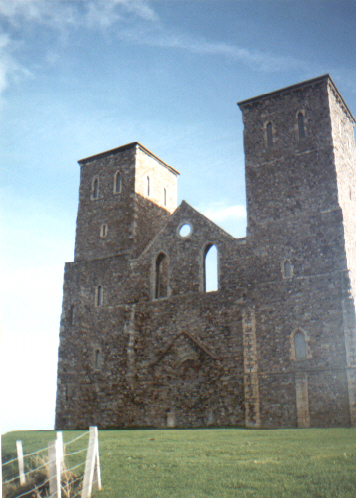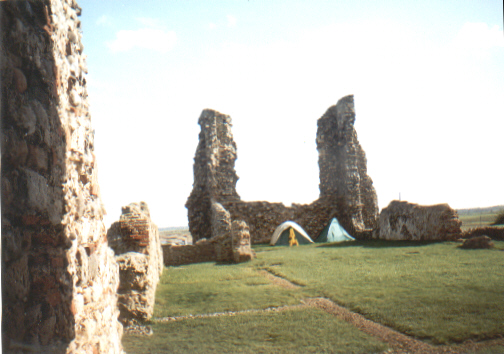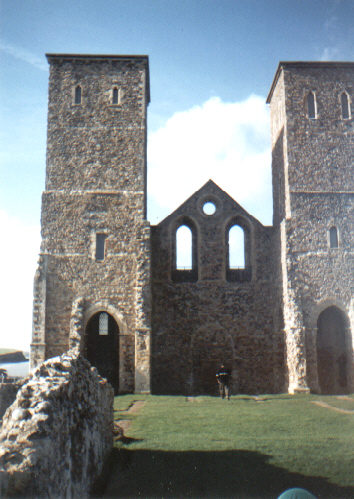|

Now only parts of the South, West and East
walls remain of this 12th Century Church built on the site of a 7th Century Christian church within the 3rd Century Roman
Fort. The site was originally almost 1 mile from the sea but now the towers teeter on the edge of the cliffs. The rest of
the church was demolished in 1809 and moved to Hilbrough to protect it from falling down due to cliff erosion. In 669 Egbert,
King of Kent granted the land for the foundation of a monastery - the Saxon Church St Mary's. The towers which remain (pictured
above) were added in the 12th century and were saved from demolition by Trinity House in 1811, due to their importance as
a landmark to sailors. The church ruins are said to be haunted by the sound of children crying, which is not surprising
as the skeletons of young children were found in the foundations during excavations in the 1960's. This site has other spirits
besides the children, there is a monk, a woman, sounds of galloping horses, and more

Originally, this was the Roman fort at what was then known as, Reculbium, which guarded the North end
of the Wantsum Channel, which cut off the Isle of Thanet from the rest of Kent. There is a legend that there is often heard
the sound of a baby crying in the grounds of the fort and the Church ruins. From information I have read, it seems that fairly
recent excavations of this site by The Kent Archaeology Society revealed several infant skeletons buried under the walls of
a Roman barrack block which would have been built in approximately 200-250 A.D, I have seen one source quote three as the
number of remains found and another which puts the figure as high as eleven. One source says that as there seemed to be no
damage to the skeletons that the infants probably died of natural causes. Whereas another says that it was not unusual
to bury the infants alive, if this were the case then one would assume that they suffocated and therefore there would not
necessarily be signs of trauma - especially given the age of the remains and the fact that they had a wall built on top
of them. Although infant mortality would have been high in those days, I personally can't see the Romans waiting for deaths
from natural causes if they needed eleven (or more) bodies to satisfy the needs of their construction, Another legend that
surrounds this site relates to the Church itself. The towers of the Church are known as "the Twin Sisters" and at one time
had an additional spire on the top of each tower. The body of the Church which had stood on the site in varying forms since
669 A.D. was demolished in 1809 but the towers were left as a navigational aid for shipping and eventually maintained by Trinity
House. The spires on top of the towers were finally removed sometime around 1880. The legend, which is a little long and complicated,
can be summarized as follows:-

In the 15th Century there were two well-connected
sisters, one of whom was the Abbess of Faversham. One of the sisters fell ill and when she recovered, the two of them decided
to go and give their thanks at the shrine of St. Mary, Bradstowe (or Broadstairs). They sailed from Faversham but off Reculver
were hit by a storm, which wrecked their ship. Both sisters were saved but one of the two died as the results of exposure.
The remaining sister then added two spires to the existing towers and they were thereafter known as the "twin sisters".
We do not have any definitive reason why the
church was abandoned but can reasonably assume it was because the coastline was being rapidly eroded at this point. As I understand
it, the churchyard was to the North of the Church itself and has been washed away by the sea long ago, together with a large
proportion of the remains of the Roman fort. Apparently, it was not unusual during the 19th Century to find the odd bone or
skull washed up on the shore having been excavated by the sea. Although, the old Church has not been used for many years now,
genealogists researching families in this area should not overlook this Church and it's newer counterpart that stands about
a mile inland.
|